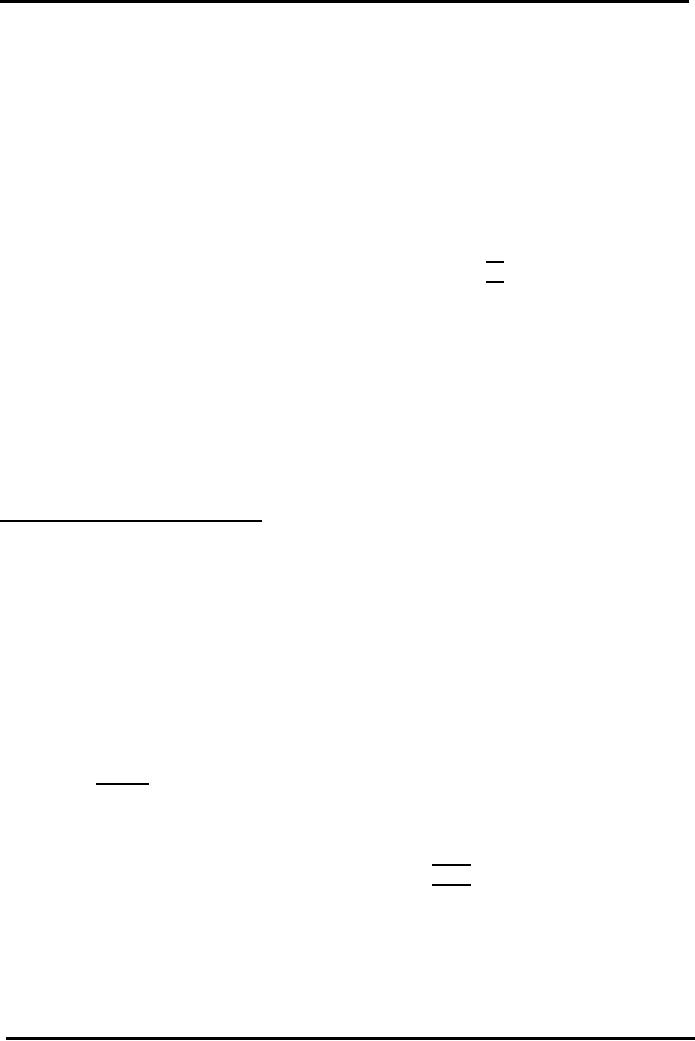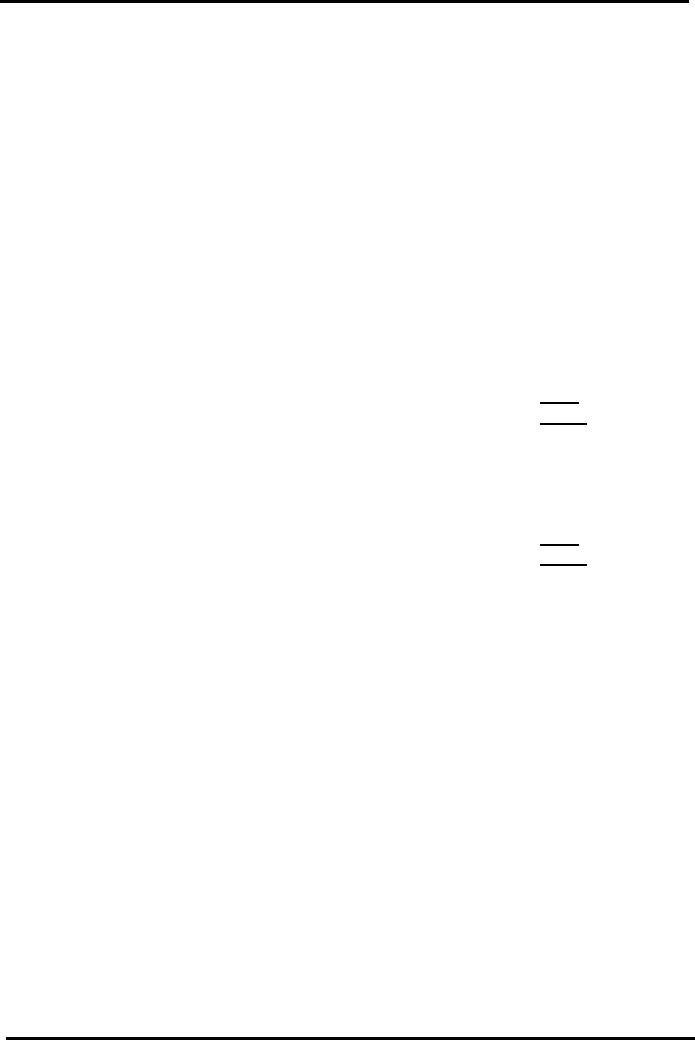 |

Cost
& Management Accounting
(MGT-402)
VU
LESSON
# 12
PAYROLL
AND INCENTIVES
Wages
are paid to the workers as
the reward of their labor
and service. Different
systems of
remuneration
have been devised for
meeting the requirements of both
employees and employers.
Usually
the employer makes a
specified monetary payment to
workers for a specified work
or job
done.
The specified monetary
payment or minimum wages
could either be related to a
particular
hours
of attendance or to the quantum of
work.
Thus
the wages are paid to
the workers either for
the time
spent by
them in an organisation or the
goods
or services produced
for it. So there are two
basic systems of remunerating
labor. One is
related
to the time and the
other relates to the quantum
of work.
In
between these two basic or
extreme systems of labor remuneration
there are a number of
vari-
ants
in vogue in many industries. Organized
trade unions and state
regulatory measures
have
significantly
contributed to the introduction of
various bonus and incentive
schemes for the
labor.
Demand
for increased wages is a
natural consequence on the
part of labor while the
employer
tends
to resist this demand.
However, it must be borne in
mind that high wages do
not necessarily
results
in higher cost of
production.
If
labor is satisfied with high
wages it may ultimately lead
to increased production and
productivity.
The
increased production and
productivity will in return results in
reduced labor and overhead
cost
per
unit. It is also essential
requirement of a good wage
system.
The
aims of a wage system should
be the introduction of a fair
wage. A good wage system
should
have,
among others, the following
features:
1.
The system of wage payment
should be fair to all
workers
2.
A guaranteed minimum wage
should be assured to all
workers.
3.
The system should be
acceptable to workers so as to avoid the
work to rule, stoppage
of
work
and slow-downs.
4.
It should have the elements
of simplicity, certainty and
flexibility.
5.
It should provide adequate incentives to
workers.
6.
It should be in conformity of various
labor laws and regulations
both local and
national.
7.
It should invariably contain an
increment clause providing
for an automatic rise in
wages
and
attendances as cost of living
index number
increases.
8.
The wage system should be
simple and practicable so as to
keep its operational and
administrative
cost at a minimum.
Systems
of Wages
Basically
there are two principal
systems of wages. They
are:
(i)
Time wage
(ii)Piece
rate or Piece work
1.
Time base wage
Under
this system, wages to a
worker are paid on time
basis irrespective of the
quantum of
production.
The wage is measured on the
basis of unit of time i.e.
hourly, daily, weekly or
monthly.
The
formula is:
Hours
worked x
Rate
per hour.
Assuming
a worker is paid Rs. 110
per hour and he has spent
200 hours during a
particular month
in
a factory, his wages will
be:
Rs.
22,000 i.e. (Time x
Rate
i.e. 200 x
Rs.110).
2.
Piece Rate wage
Under
this method of remuneration a
worker is paid on the basis
of production and not time
taken
by
him to perform the work.
This is one of the simplest
and most commonly used of
all incentive
84

Cost
& Management Accounting
(MGT-402)
VU
schemes.
The rate is expressed in terms of certain
sum of money for every unit
produced, e.g. Rs 2
per
unit. The formula
is:
Units
produced x
Rate
per unit.
Suppose
a worker is paid Re. 50 per
unit and he has produced 20
units in 7 hours. His total
wages
will
be:
Rs.
1,000 i.e. (Units x
Rate
i.e. 20 x
Rs.50)
However,
a well regulated piece rate
system has a guaranteed
minimum wage. A well
regulated
piece
rate system, with a
guaranteed minimum wage rate
of compensation is much superior
over
the
time rate system.
Piece
rate with guaranteed wage
rate
Under
this system a worker
receives the straight piece
rate for the number of
pieces he produces,
provided
that his total remuneration is
more than his earnings on a
time rate basis. If the
piece rate
earnings
fall below the minimum
level of his earnings then he is
paid on the time rate
basis per
hour/per
day).
Premium
Plans
In
between the two principal
systems of remuneration described
above, there are a variety
of
bonus
and premium plans of compensating
workers for their extra
efforts and skills. The
basic
objectives
of various bonus and premium
plans are:
a.
to induce the workers to increase
the production and
productivity,
b.
to provide them additional wages
for their skill and
efforts,
c.
to raise the morale of the
labor high,
d.
to reduce the cost of
production,
e.
to retain the services of good
workers,
f.
to induce the workers to serve
the organisation with loyalty
and sincerity, and
g.
to establish better labor-management
relations.
Essential
futures of sound wage incentive
plan:
Various
incentive wage schemes have
been designed to overcome the
drawbacks of two
principal
systems
of labor compensation. A system of wage
payment that would ensure
both quality and
quantity
of product is known as Incentive or
Bonus or Premium plan. Essentially,
all incentive
plans
are a combination of the two
basic wage plans, i.e.,
time rate and piece
rate.
The
following are some essential
features of an incentive
plan:
1.
The plan should be
acceptable to the workers, trade
unions and
management.
2.
The incentive should be
related to the efforts
involved and should be
sufficiently high
so
as to provide inducement to greater
effort.
3.
It should be simple and
should be understood by all
workers easily.
4.
The standard time or norms
upon which wage incentive is
based should be determined
on
the basis of lime and
motion studies.
5.
Standards once fixed should
not be changed unless it is
necessitated by the change
in
the
method of work. Likewise
unilateral and unwarranted
rate cuttings should
be
avoided.
6.
No upper limit should be
placed upon the amount of
individual earnings.
7.
The incentive plan should be
aim at increasing production, reducing
cost, and should
influence
the workers morale.
8.
The scheme should be
operated without excessive
and operative cost.
9.
It should be consistent and incentive
should be based on properly
assessed lime values
of
respective jobs.
85

Cost
& Management Accounting
(MGT-402)
VU
10.
The scheme should motivate
the employees towards attainment of
management
objectives
by means of coordinated efforts of all
concerned.
11.
The grievances of the
workers especially in respect of
work standard and
incentive
rates
should be removed at once.
The
success of an incentive plan largely
depends on the mutual
co-operation and
understanding
between
employer and employees and
immediate removal of workers'
grievances. And above
all,
the
payments of incentive or bonus should be
made as soon as possible after
the work is
completed.
Some
Important Incentive Wage
Plans:
Some
of the important incentive
wage plans are briefly
discussed here with practical
examples.
These
are:
Time
Rate Based Premium
Plan
(1)
Halsey Premium Plan.
(2)
Halsey-Weir Premium System.
(3)
Rowan Plan.
Piece
Rate Based Premium
Plan
(4)
Taylor's Differential Piece
Rate System.
(5)
Merrick Differential Piece
Rate Plan-
While
calculating total earnings of a worker
under different incentive
wage schemes, the
following
four
elements must be taken into account:
(i)
Unit of output, (ii)
Standard time, (iii)
Time
worked,
and (iv) Time
saved.
Time
Rate Based Premium
Plans
Halsey
Premium Plan
Under
this system, a standard time
is fixed for each job or
operation. Time rate is guaranteed to
a
worker
and if he completes the job
within standard time or more
than the standard time, he
is paid
standard
rate.
But
if the Job is completed in less
than the standard time
fixed for the job, he is
given wages for
the
actual hours taken plus
bonus equal to one half of
the wage of the time
saved.
Gross
Wages = (Time worked x wage
rate) + (½ Time saved x wage
rate)
PRACTICE
QUESTION
Q.
1
Wage
rate per hour
Rs.
1.50
Time
allowed for the job
16
hours
Time
taken
12
hours.
Required:
1.
Calculate the Gross earnings of
the worker.
2.
Find out effective "rate of
earnings"
Solution:
(Halsey premium
plan)
Gross
Earnings
Basic
Pay
12
x 1.5
=
18
Bonus
Pay
½
(4)x 1.5
=
3
21
Effective
rate of earning
Rs21/12
hours =
Rs. 1.75
86

Cost
& Management Accounting
(MGT-402)
VU
Halsey-Weir
Premium Plan
Under
this method, other things
being the same as Halsey Plan,
the rate of premium
usually
applied
is 33.33: 66.67 sharing plan
basis. In practice the bonus
is on a 50: 50 sharing
scheme.
Q.
2
Calculate
the total earnings and
effective rate of earning per
hour from the practice
question given
above,
if the worker is paid
according to Halsey-Weir premium
plan.
Solution:
(Halsey-Weir premium
plan)
Gross
Earnings
Basic
Pay
12
x 1.5
=
18
Bonus
Pay
33.33%
of (4) x 1.5
=
2
20
Effective
rate of earning
Rs20/12
hours =
Rs. 1.67
Rowan
Premium Plan
This
system is similar to the above
two plans. The worker is
guaranteed at ordinary rate of
wages
and
bonus is paid in respect of
time saved.
Under
the Rowan system the
bonus hours are calculated
as the proportion of the
time taken which
the
time saved bears to the
standard time allowed.
Thus
under this system a
different method of calculating bonus is
applied.
Step
I
The
bonus rate is calculated
as:
Time
allowed Actual time taken
x 100 = %
Time
allowed
Step
II
This
bonus rate is then applied
on the basic pay to
calculate the bonus
pay.
Basic
Pay x bonus rate = bonus
pay
Q.
3
Calculate
the total earnings and
effective rate of earning per
hour from the practice
question given
above,
if the worker is paid under
Rowan bonus plan.
Solution:
(Rowan premium
plan)
Bonus
rate = 16 12 x 100 =
25%
16
Gross
Earnings
Basic
Pay
12
x 1.5
=
18.00
Bonus
Pay
18
x 25%
=
4.50
22.50
Effective
rate of earning
Rs
22.5/12 hours
=
Rs. 1.875
OVERTIME
Normally
an employee is required to work for a
set number of hours every
week. There may
however
be occasions where the employer
will ask the employee to
work for longer
hours.
Overtime
is the time worked over
and above the employee's
basic working week.
87

Cost
& Management Accounting
(MGT-402)
VU
Overtime
must not be confused with
flex-time. In a flex-time system an
employee is allowed to
work
extra hours earlier in the
week or month, in return for
which he will work fewer
hours later
on.
His overall number of hours
worked remains
constant.
Overtime
is time that is paid for,
usually at a premium, over
and above the basic
hours for the
period.
Overtime
by direct workers might be incurred
for two reasons:
-
Either
to make up for lost time
earlier in the production
process or
-
In
order to produce more of the
product than was originally
anticipated.
Overtime
being worked means that
more units of a product are
produced. However, if the
overtime
is being worked to make up
for lost production earlier
in the process then the
units
produced
in the overtime may simply
be enough to bring production
back up to its anticipated
level.
Overtime
that is being worked in
order to make up for
unnecessarily lost production
time is
avoidable
and should not have
occurred.
Overtime
that is necessary in order to
fulfill customer orders is unavoidable
overtime.
Calculating
Overtime Pay
Hourly
Paid Workers
Hourly
paid workers may be paid
overtime at various different rates.
For example, the hourly
rate
of
overtime may be the same as
the basic rate of pay or
higher than the basic
rate of pay.
It
may either be expressed as a
higher monetary amount, or as a
proportion of basic pay, such as
'time
and a half.
The
hourly rate of overtime may
vary according to when the
overtime is worked. For
example the
evening
rate may be 'time and a
half, whereas the weekend
rate may be 'double
time'.
The
hourly rate may vary
with the number of overtime
hours worked. For example
the first 5
hours
may be at 'time and a half,
and additional hours at 'double
time'.
Weekly
Paid Workers
The
overtime pay is the number
of hours of overtime worked,
multiplied by the rate at
which
overtime
is paid.
88

Cost
& Management Accounting
(MGT-402)
VU
PRACTICE
QUESTION
S
normally works a 35 hour
week, and is paid Rs.5
per hour. In one week she
works 12 hours of
overtime,
one hour each week day, and
7 hours on Saturday.
How
much is her overtime-pay
if:
(a)
She is paid time and a
half for all overtime
hours?
(b)
She is paid time and a
half for evening overtime
and double time for
weekend overtime?
(c)
She is paid time and a
half for the first 8
hours overtime and double
time thereafter?
Solution
S's
overtime pay is:
(a)
Basic
rate of pay
Rs.
5 per hour
Overtime
rate of pay
Rs.
5 x 1 ½ times = Rs. 7.50 per
hour
Overtime
pay
12
hours @ Rs.7.50 per hour =
Rs. 90.00
(b)
Basic
rate of pay
Rs.
5 per hour
Overtime
rate of pay evenings Rs. 5 x
1 ½=
Rs.
7.50 per hour Overtime
rate of
pay
weekends
Rs. 5 x 2
=
Rs. 10.00 per
hour
Overtime
pay 5 hours @ Rs. 7.50
per hour
37.50
7
hours @ Rs. 10.00 per
hour
70.00
107.50
(c)
Basic
rate of pay
Rs.
5 per hour
Overtime
rate of pay -first 8 hours
Rs. 5 x 1 ½
=
Rs.
7.50 per hour
Overtime
rate of pay-excess hours Rs.
5x2
=
Rs. 10.00 per
hour
Overtime
pay 8 hours® Rs. 7.50
per hour
60.00
4
hours® Rs. 10.00 per
hour
40.00
100.00
Salaried
Staff
Not
all salaried staff will be
paid overtime. If they are,
the rate at which overtime
is paid may vary
according
to when the overtime is
worked, in precisely the
same way as for weekly paid
employees.
The
difference is that the pay of
salaried staff is usually
expressed as an annual rate,
and this must
be
converted to an hourly rate before
the overtime can be
calculated.
This
is done by dividing the annual
salary by 52 to give the weekly
salary, and further dividing
this
by
the number of hours an
employee is contracted to work
for.
It
should be noted that the
contract of employment may override
this calculation, setting a rate
of
overtime
pay.
PRACTICE
QUESTION
Alee
works a 35 hour week for an
annual salary of Rs.18,200. He is
expected to work up to 5
hours
of
overtime for no extra pay, but
thereafter will be paid
overtime pay at the rate of
time and a half.
One
week he works 8 hours of
overtime. What is his overtime
pay?
Solution
Hint:
There
are 52 weeks in a year and there are 35
working hours in a week
Alee's
basic hourly rate of pay
is:
Rs.18,200
x 1/52 x 1/35 =Rs.10
The
hourly rate of overtime pay, at
time and a half
is:
Rs.10
x 1 ½ =Rs.15.00
Alee
will not be paid for
the first 5 hours of
overtime so his overtime pay
is:
(8
- 5) hours = 3 hours @ Rs.15 =
Rs.45.00
89

Cost
& Management Accounting
(MGT-402)
VU
COMMISSION
In
some jobs, employees may be remunerated
by a basic salary, plus an additional
amount
specifically
related to that employee's
performance.
Commission
is an amount paid to an employee
based on that employee's
performance.
Commission
is most commonly paid to
salesmen, based on the
volume of sales that they
have
achieved
in a given period. In some cases they
may have a very low
basic salary, so that
commission
forms the largest part of
their pay.
In
its simplest form, commission will
usually be expressed as a percentage of
sales achieved in the
previous
period e.g. 1% of sales.
Commission
may also be paid at
different scales, so that
the higher the sales,
the higher the
commission.
For example, a salesman may
be paid 2% commission on the first
Rs.10,000 of sales,
2.5%
on the next Rs.10,000, and
3% on any additional sales.
This
basis may be appropriate where an
employee sells a large
number of small value items. If he
sells
instead higher value contracts, the
level of commission may vary
with the value of the
contract.
For example the rate of
commission may be 2% for contracts worth
up to Rs.10,000,
2.5%
for contracts worth up to Rs.20,000,
and 3% for larger
contracts.
Since
the incentive is for the
employee to make a large
volume of sales, it is important
for the
employer
to ensure that the salesman
is only rewarded for good
sales. The commission
scheme
may
contain a proviso that the
commission will only be paid
once the customer has paid
up, or
once
the customer's creditworthiness has
been checked.
PRACTICE
QUESTION
Haroon
is a salesman, selling machinery. He
receives a commission of 2% on all sales,
with an
additional
0.5% for any item of
machinery selling for more
than Rs.10,000. In addition he
receives
a
further 0.5% on sales in
excess of Rs.100,000 per
month.
During
July his total sales
amounted to Rs.110,000. Included in
this were two expensive
machines,
one
selling for Rs.12,000, and
the other for
Rs.17,000.
How
much commission does Haroon
earn?
Solution
Haroon
earns commission of:
Rs.
Basic
commission Rs.110,000 x 2%
2,200
Expensive
machines Rs. (12,000 +
17,000) x 0.5%
145
Sales
over Rs.100,000 Rs.(110,000-100,000) x
0.5%
50
Total
commission
2,395
90

Cost
& Management Accounting
(MGT-402)
VU
PROBLEM
QUESTIONS
Q.
1
From
the information given below
calculate the earnings of
each employee, under the
following
methods
of wage payment.
(i)
Halsey
Premium Bonus Scheme.
(ii)
Halsey-Weir
Premium Bonus Scheme.
(iii)
Rowan
Premium Bonus Scheme.
Employee
A
B
C
Time
allowed hours per 100
units
35
40
42
Wages
per unit Rs.
2
3
4
Hourly
rate Rs.
7
8
10
Actual
time taken in hours
50
48
46
Actual
units produced
200
150
125
Q.
2
Ten
men work as a group. When
the weekly production of the
group exceeds standard (200
pieces
per
hour) each man in the
group is paid a bonus for
the excess production in
addition to his wages
at
hourly rates. The bonus is
computed thus:
The
percentage of production in excess of
the standard amount is found
and one half of this
percentage
is considered as the men's
share. Each man in the group
is paid as a bonus
this
percentage
of a wage rate of 50 paisa
per hour. There is no
relationship between the
individual
work
man's hourly rate and
the bonus rate. The
following is one week's record:
Days
Hours
worked
Production
Monday
90
22,100
Tuesday
88
20,600
Wednesday
90
24,200
Thursday
84
20,100
Friday
88
20,400
Saturday
40
10,200
Total
480
117,600
(i)
Compute
the rate and amount of
bonus for the
week.
(ii)
Compute
the total pay of "A" who
worked 41 hours and was
paid 35 paisa per
hour
basic
and of "B" who worked 44
hours and was paid 30
paisa per hour
basic.
Q.
3 Using
the information given below
you are required to calculate
the amounts earned by
each
employee
under each of the following
remuneration methods:
(i)
Piece
work (with guaranteed hourly
rates)
(ii)
Hourly
rate;
(iii)
Bonus
system (under which the
employee receives 50%
of time
savings).
Also
calculate the gross wages
paid to each employee under
each of the above
method.
Employee
Employee
Employee
A
B
C
Time
allowed:
Hours
per 100 units
23
32
38
Price
per unit in Paisa
12
20
15
Guaranteed
hourly rate
Re.
0.60
Re.
0.75
Re.
0.50
Actual
time taken in hours
40
42
39
Actual
units produced
200
125
150
91

Cost
& Management Accounting
(MGT-402)
VU
Q.
4
(a)
How is incentive wages
calculated under (i)
Halsey
and (ii) Rowan incentive
schemes of wages
payment?
Explain the difference
between them and the
advantage to the worker
under these two
methods
of incentive payment.
(b)
From
the following data tabulate
the total earnings per
hour of each worker
separately under (i)
Halsey
and (ii)
Rowan
schemes of incentive
payment.
(a)
Worker
A
B
C
D
E
F
(b)
Time
allowed hrs.
3
4
5
6
7
8
(c)
Actual time hrs.
5
3
4
5
3
3
(d)
Basic wages per hrs. in
Rs. 2
2
2
2
2
2
Q.
5
Kirn
is paid commission of 5% on the first
Rs.20,000 of sales, and 7,5%
on any sales in excess of
this
amount. However she is only
paid the commission when
either the customer has
paid for the
order,
or has taken out a financing
agreement.
In
October she made sales of
Rs.35,000, However two customers
refused to pay or take out
a
financing
agreement. One had ordered
goods costing Rs.1,500, and
the other goods
costing
Rs.2,500.
How
much commission will Kirn
receive?
92
Table of Contents:
- COST CLASSIFICATION AND COST BEHAVIOR INTRODUCTION:COST CLASSIFICATION,
- IMPORTANT TERMINOLOGIES:Cost Center, Profit Centre, Differential Cost or Incremental cost
- FINANCIAL STATEMENTS:Inventory, Direct Material Consumed, Total Factory Cost
- FINANCIAL STATEMENTS:Adjustment in the Entire Production, Adjustment in the Income Statement
- PROBLEMS IN PREPARATION OF FINANCIAL STATEMENTS:Gross Profit Margin Rate, Net Profit Ratio
- MORE ABOUT PREPARATION OF FINANCIAL STATEMENTS:Conversion Cost
- MATERIAL:Inventory, Perpetual Inventory System, Weighted Average Method (W.Avg)
- CONTROL OVER MATERIAL:Order Level, Maximum Stock Level, Danger Level
- ECONOMIC ORDERING QUANTITY:EOQ Graph, PROBLEMS
- ACCOUNTING FOR LOSSES:Spoiled output, Accounting treatment, Inventory Turnover Ratio
- LABOR:Direct Labor Cost, Mechanical Methods, MAKING PAYMENTS TO EMPLOYEES
- PAYROLL AND INCENTIVES:Systems of Wages, Premium Plans
- PIECE RATE BASE PREMIUM PLANS:Suitability of Piece Rate System, GROUP BONUS SYSTEMS
- LABOR TURNOVER AND LABOR EFFICIENCY RATIOS & FACTORY OVERHEAD COST
- ALLOCATION AND APPORTIONMENT OF FOH COST
- FACTORY OVERHEAD COST:Marketing, Research and development
- FACTORY OVERHEAD COST:Spending Variance, Capacity/Volume Variance
- JOB ORDER COSTING SYSTEM:Direct Materials, Direct Labor, Factory Overhead
- PROCESS COSTING SYSTEM:Data Collection, Cost of Completed Output
- PROCESS COSTING SYSTEM:Cost of Production Report, Quantity Schedule
- PROCESS COSTING SYSTEM:Normal Loss at the End of Process
- PROCESS COSTING SYSTEM:PRACTICE QUESTION
- PROCESS COSTING SYSTEM:Partially-processed units, Equivalent units
- PROCESS COSTING SYSTEM:Weighted average method, Cost of Production Report
- COSTING/VALUATION OF JOINT AND BY PRODUCTS:Accounting for joint products
- COSTING/VALUATION OF JOINT AND BY PRODUCTS:Problems of common costs
- MARGINAL AND ABSORPTION COSTING:Contribution Margin, Marginal cost per unit
- MARGINAL AND ABSORPTION COSTING:Contribution and profit
- COST VOLUME PROFIT ANALYSIS:Contribution Margin Approach & CVP Analysis
- COST VOLUME PROFIT ANALYSIS:Target Contribution Margin
- BREAK EVEN ANALYSIS MARGIN OF SAFETY:Margin of Safety (MOS), Using Budget profit
- BREAKEVEN ANALYSIS CHARTS AND GRAPHS:Usefulness of charts
- WHAT IS A BUDGET?:Budgetary control, Making a Forecast, Preparing budgets
- Production & Sales Budget:Rolling budget, Sales budget
- Production & Sales Budget:Illustration 1, Production budget
- FLEXIBLE BUDGET:Capacity and volume, Theoretical Capacity
- FLEXIBLE BUDGET:ANALYSIS OF COST BEHAVIOR, Fixed Expenses
- TYPES OF BUDGET:Format of Cash Budget,
- Complex Cash Budget & Flexible Budget:Comparing actual with original budget
- FLEXIBLE & ZERO BASE BUDGETING:Efficiency Ratio, Performance budgeting
- DECISION MAKING IN MANAGEMENT ACCOUNTING:Spare capacity costs, Sunk cost
- DECISION MAKING:Size of fund, Income statement
- DECISION MAKING:Avoidable Costs, Non-Relevant Variable Costs, Absorbed Overhead
- DECISION MAKING CHOICE OF PRODUCT (PRODUCT MIX) DECISIONS
- DECISION MAKING CHOICE OF PRODUCT (PRODUCT MIX) DECISIONS:MAKE OR BUY DECISIONS